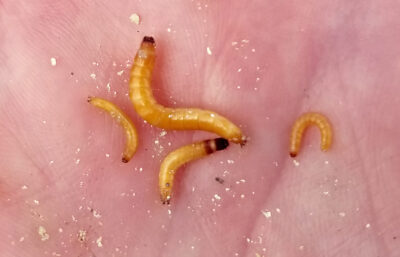Wireworm a threat to local cereal crops
By Tim Kalinowski on June 2, 2021.
 Submitted photo by Haley Catton, AAFC -
Wireworm is a common problem in local fields, and in larval form (pictured) can be quite damaging to crops.
Submitted photo by Haley Catton, AAFC -
Wireworm is a common problem in local fields, and in larval form (pictured) can be quite damaging to crops.LETHBRIDGE HERALDtkalinowski@lethbridgeherald.com
Local insect scientists with the Agriculture and Agri-Food Lethbridge Research and Development Centre are searching for ways to help local cereal farmers assess their wireworm problems and make management decisions on what costs to invest in treatment of these problems.
AAFC entomology researcher Haley Catton is leading a research study of 12 local fields which either currently have or have had wireworm problems in the past. The plan is to use aerial drone photography to map thinning spots in these fields where wireworm may be present.
“Wireworm is one of our biggest cereal crop pests down here in southern Alberta,” says Catton, “and they are a ground dwelling, larval stage of a (click) beetle. One of the challenges with wireworms is they are really hard to monitor because they are in the ground. The only way currently a farmer can really decide to use a chemical seed treatment or not is to look for bare patches in the crop, and do a bit of digging around to see if the wireworms are there. So it is kind of a guessing game right now.
“What we are trying to do is use overhead imagery to really analyze how crop thinning is happening in a field,” she adds, “and if those thin patches are associated with wireworms or not.”
Catton says all different types of wireworms are a native species to the Prairies, and can live in the soil for three to five years before emerging for just a few weeks at the end of their lifecycles in beetle form to lay more eggs.
There is no topical pesticide which can be applied to kill wireworms eating away the roots and seeds of cereals and other crop plants, but farmers can use expensive chemical seed treatments prior to planting to deal with a heavy infestation of them. The problem, says Catton, is farmers have no easy way of judging the best economic threshold to make chemical treatment worthwhile.
If her team can photograph and identify a problem through a comparative analysis of the 12 fields, and ground truth it the next spring by a follow up onsite analysis using digging, then maybe, Catton says, a photograph becomes enough information for a farmer to make a decision on seed treatment next spring.
“We are going to photograph wheat fields this summer and see where the problems are, and then we are going to go back next spring and sample to see if these insects are there,” Catton says. “In a perfect world a farmer can take a picture of a crop this year and then decide whether next year they need seed treatment or not.”
Follow @TimKalHerald on Twitter
4-3


